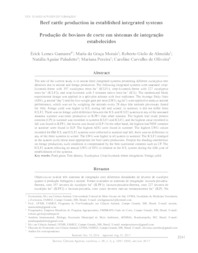Beef cattle production in established integrated systems.
Beef cattle production in established integrated systems.
Author(s): ALMEIDA, R. G. de
Summary: The aim of the current study is to assess three integrated systems presenting different eucalyptus tree densities due to animal and forage production. The following integrated systems were assessed: croplivestock- forest with 357 eucalyptus trees ha-1 (ICLF1); crop-livestock-forest with 227 eucalyptus trees ha-1 (ICLF2); and crop-livestock with 5 remnant native trees ha-1 (ICL). The randomized block experimental design was applied in a split-plot scheme with four replicates. The Average Daily Gain (ADG, g animal-1day-1) and the live-weight gain per area (LWG, kg ha-1) were applied to analyze animal performance, which was set by weighing the animals every 28 days (the animals previously fasted for 16h). Forage yield was higher in ICL during fall and winter; in summer, it did not differ from ICLF2. There was no forage yield difference between the ICL and ICLF2 systems in any of the assessed seasons; summer was more productive in ILPF1 than other seasons. The highest leaf crude protein contents (CP) in summer was recorded in systems ICLF1 and ICLF2, and the highest value recorded in fall was found in ILPF1; the lowest was found in ILP. On the other hand, the highest leaf NDF contents in summer were found in ILP. The highest ADG were found in summer. The highest LWG values recorded for the ICL and ICLF2 systems were collected in summer and fall; there was no difference in any of the three systems in winter. The LWG was higher in all system in summer. The ICLF2 emerged as the system (with trees) most appropriate for beef cattle production. Despite the shading interference on forage production, such condition is compensated by the best nutritional contents such as CP. The ICLF2 system allowing an annual LWG of 83% in relation to the ICL system during the fifth year of establishment of the systems.
Publication year: 2017
Types of publication: Journal article
Unit: Embrapa Beef Cattle
Observation
Some of Embrapa's publications are published as ePub files. To read them, use or download one of the following free software options to your computer or mobile device. Android: Google Play Books; IOS: iBooks; Windows and Linux: Calibre.
Access other publications
Access the Agricultural Research Database (BDPA) to consult Embrapa's full library collection and records.
Visit Embrapa Bookstore to purchase books and other publications sold by Embrapa.

